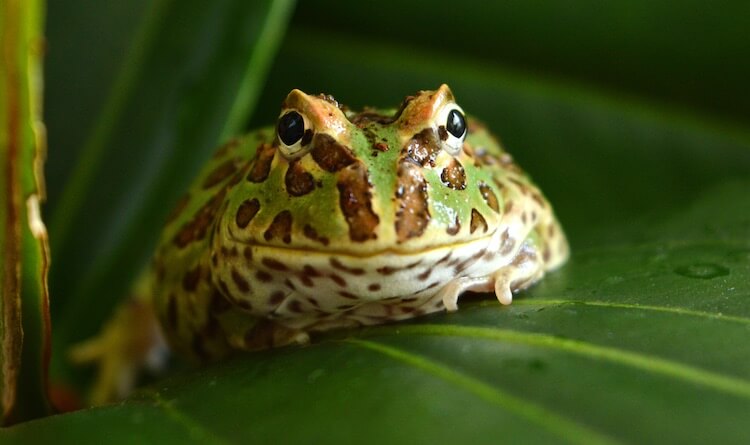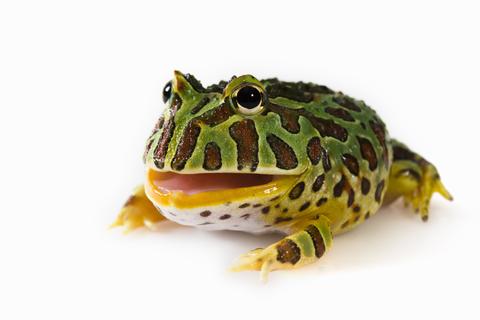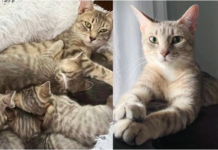Last Updated on August 6, 2021 by Fumipets
Pacman frogs are amphibians native to South America that are very popular in the pet trade. They are poor swimmers since they are exclusively terrestrial amphibians. Instead, they spend most of their time amid wet leaf litter in a humid habitat. Pacman frogs receive their name from the famous PacMan arcade game because they have a rounded look and large lips, similar to the cartoon figure. Pacman frogs are easy to take care of and make fascinating pets. The Pacman frog, on the other hand, may not be a suitable fit for those who like their pets to be active or engaging, since it is not the greatest pet to handle.
The Temperament and Behavior of Pacman Frogs
Although these amphibians make good pets, their wild cousins have been known to bite if they feel threatened. The hunger of a Pacman frog is proportional to its size, and it will consume everything that moves within striking reach of where it rests on the ground. This greedy frog will eat any type of creature that passes by.

Housing the Pacman Frog
Because Pacman frogs are not particularly active, they do not need a big cage. For one of these frogs, a 20-gallon tank will be enough. They should be kept alone since they will frequently attempt to devour their cage mates. Although a cage top is suggested to assist regulate temperature and humidity, Pacman frogs have never been known to escape.
The tank may be lined with paper or smooth pebbles as long as there is enough leaf litter, moss, and real or fake plants for a Pacman frog to burrow in or hide. Misting the substrate on a regular basis will assist maintain the tank humidity between 50 and 80 percent.
A small dish of water, large enough for the frog to sip and sit in without drowning, should also be supplied. Your Pacman frog may spend a lot of time in its water dish depending on how humid your tank is, so placing plants around the dish can make your frog feel more comfortable. To prevent the water from becoming too cold, the water dish should be placed in a warmer area of the cage.

Heat
The tank’s temperature should be maintained at 82 degrees Fahrenheit during the day and dropped to about 78 degrees Fahrenheit at night. Because overhead incandescent lights may be too drying for your frog, an under-tank heater is an ideal option (although a red incandescent could be used if supplemental heat is needed at colder times).
Light
A fluorescent fixture may be used for illumination, but your frog may prefer more muted lighting; normal room light may be sufficient. Maintain a 12-hour cycle of light and darkness. For this 12-hour period, some owners suggest using a UVA/UVB light.
Food and Water
Because Pacman frogs are not picky eaters, they are quite simple to feed. Smaller Pacman frogs may be given crickets or other prey insects from the pet shop, such as mealworms and wax worms that have been stomach loaded before feeding.
Pinkie (newborn) mice, then bigger mice, may be given to your frog as it develops. Frogs of adult size can eat a medium-sized mouse or pinkie rat. Your Pacman frog may also be fed guppies, a variety of insects, and even smaller frogs.
Small Pacman frogs that consume insects should be fed every day, while bigger frogs who eat mice or feeder fish should only be fed every few days. Feeding depending on your frog’s body condition is the greatest guide: if your frog is becoming too round and fat, reduce how frequently it is fed.

Typical Health and Behavioural Issues
The Pacman frog is not immune to bacterial and fungal infections of the skin and eyes, which are among the most frequent diseases among amphibians. Infection is indicated by redness, swelling, or pus.
Parasitic infections may also affect Pacman frogs.
Bring your frog to an expert exotics vet to rule out parasitism if your tank temps are warm enough and your frog is still not eating properly. An annual faecal sample should also be examined to ensure that your frog isn’t infected with common parasites.
A Pacman frog maintained in a cage with insufficient humidity may develop a respiratory illness, which is less frequent in frogs than in other reptiles and amphibians. Wheezing, drooling, and tiredness are all symptoms of this condition. Keep an eye out for ammonia toxicity as well. When excrement in an animal’s enclosure is not adequately cleaned, this potentially deadly situation occurs.
If discovered early enough, any of the aforementioned diseases may be treated by a veterinarian.

Choosing a Pacman Frog
When choosing a Pacman frog to keep as a pet, aim for an energetic, alert animal with clean eyes and blemish-free skin. If you can observe it eat before making a decision, that’s great; Pacman frogs seldom reject food unless they’re sick. If the Pacman frog you’re interested in seems tired or has difficulty breathing, or if its belly appears swollen, it may be sick. 3
A reliable breeder that can provide you with a full health history on your prospective pet is your best option for getting a Pacman frog. Captive-bred Pacman frogs are preferable to wild-caught frogs because they are less likely to be infected with parasites and other diseases.


















